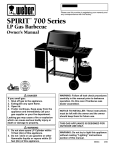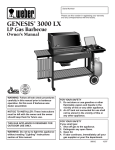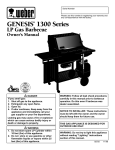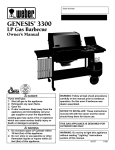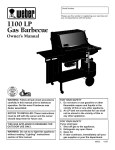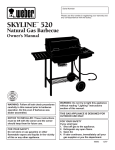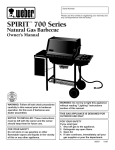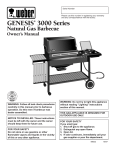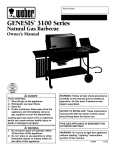Download Weber 3400 LP Owner`s manual
Transcript
3400 Series ® LP Gas Barbecue ® Operating Guide Serial Number Please use this number in registering your warranty and any correspondence with the factory. , , , , ,,, , , , ® ® E F WARNING: Follow all leak check procedures carefully in this manual prior to barbecue operation. Do this even though the barbecue is assembled. NOTICE TO INSTALLER: These instructions must be left with the owner and the owner should keep them for future use. THIS GAS APPLIANCE IS DESIGNED FOR OUTDOOR USE ONLY. WARNING: Do not try to light this appliance without reading "Lighting" instructions section of this manual. ® gama National PROPANEGAS Association FOR YOUR SAFETY 1. Do not store or use gasoline or other flammable vapors and liquids in the vicinity of this or any other appliance. 2. An LP tank not connected for use shall not be stored in the vicinity of this or any other appliance. FOR YOUR SAFETY If you smell gas: 1. Shut off gas to the appliance. 2. Extinguish any open flame. 3. Open lid. 4. If odor continues, immediately call your gas supplier or your fire department. 63602 2/95 DANGER Failure to follow the Dangers, Warnings and Cautions contained in this Owner’s Manual may result in serious bodily injury or death, or in a fire or an explosion causing damage to property. WARNINGS ■ Do not store a spare or disconnected LP tank under or near this barbecue. ■ Improper assembly may be dangerous. Please carefully follow the assembly instructions in this manual. ■ After a period of storage, and/or nonuse, the Weber Gas Barbecue should be checked for gas leaks and burner obstructions before using. See instructions in this manual for correct procedures. ■ Do not operate the Weber Gas Barbecue if there is a gas leak present. ■ Do not use a flame to check for gas leaks. ■ Combustible materials should never be within 24 inches of the top, bottom, back or sides of your Weber Gas Barbecue. ■ Do not put a barbecue cover or anything flammable on or in the storage area under the barbecue. ■ Your Weber Gas Barbecue should never be used by children. ■ You should exercise reasonable care when operating your Weber Gas Barbecue. It will be hot during cooking or cleaning, and should never be left unattended. ■ Should the burners go out during operation, turn all gas valves off. Open the lid and wait five minutes before attempting to relight, using the lighting instructions. ■ Do not use charcoal or lava rock in your Weber Gas Barbecue. ■ Never lean over open grill or place hands or fingers on the front edge of the cooking box. ■ Should a grease fire occur, turn off all burners and leave lid closed until fire is out. ■ Do not enlarge valve orifices or burner ports when cleaning the valves or burners. ■ The Weber Gas Barbecue should be thoroughly cleaned on a regular basis. ■ LP gas is not natural gas. The conversion or attempted use of natural gas in an LP unit or LP gas in a natural gas unit is dangerous and will void your warranty. ■ Do not attempt to disconnect any gas fitting while your barbecue is in operation. LP GAS UNITS ONLY: ■ Use the regulator that is supplied with your Weber Gas Barbecue. ■ Do not attempt to disconnect the gas regulator or any gas fitting while your barbecue is in operation. ■ A dented or rusty LP tank may be hazardous and should be checked by your liquid propane supplier. Do not use an LP tank with a damaged valve. ■ Although your LP tank may appear to be empty, gas may still be present, and the tank should be transported and stored accordingly. ■ If you see, smell or hear the hiss of escaping gas from the LP tank: 1. Get away from LP tank. 2. Do not attempt to correct the problem yourself. 3. Call your fire department. 2 WARRANTY Weber-Stephen Products Co. (Weber) hereby warrants to the ORIGINAL PURCHASER of this Weber Gas Barbecue that it will be free of defects in material and workmanship from the date of purchase as follows: There are no other express warrants except as set forth herein and any applicable implied warranties of merchantability and fitness are limited in duration to the period of coverage of this express written Limited Warranty. Some states do not allow limitation on how long an implied warranty lasts, so this limitation may not apply to you. Aluminum Castings, 10 years, Recycled Work Surfaces, 10 years Stainless Steel Flavorizer Bars, 5 years Weber is not liable for any special, indirect or consequential damages. Some states do not allow the exclusion or limitation of incidental or consequential damages, so this limitation or exclusion may not apply to you. Cooking Grates , 3 years, All Remaining Parts, 5 years, when assembled and operated in accordance with the printed instructions accompanying it. Weber does not authorize any person or company to assume for it any other obligation or liability in connection with the sale, installation, use, removal, return, or replacement of its equipment; and no such representations are binding on Weber. Weber may require reasonable proof of your date of purchase. THEREFORE, YOU SHOULD RETAIN YOUR SALES SLIP OR INVOICE. This Limited Warranty shall be limited to the repair or replacement of parts which prove defective under normal use and service and which on examination shall indicate, to Weber's satisfaction, they are defective. Before returning any parts, contact Weber-Stephen Products Co. Customer Service Center. If Weber confirms the defect and approves the claim, Weber will elect to replace such parts without charge. If you are required to return defective parts, transportation charges must be prepaid. Weber will return parts to the purchaser, freight or postage prepaid. This Warranty applies only to products sold at retail. WEBER-STEPHEN PRODUCTS CO. Customer Service Center 250 South Hicks Road Palatine, IL 60067-6241 (708) 705-8660 (800) 446-1071 This Limited Warranty does not cover any failures or operating difficulties due to accident, abuse, misuse, alteration, misapplication, vandalism, improper installation or improper maintenance or service, or failure to perform normal and routine maintenance, including but not limited to damage caused by insects within the burner tubes, as set out in this owner's manual. LP Tank The LP tank manufacturer is responsible for the materials, workmanship and performance of the tank. If the tank has a defect, malfunctions, or you have a question regarding the tank, call the tank manufacturer's customer service center. The phone number is on the warning decal which is permanently attached to the tank. If the tank manufacturer has not resolved the issue to your satisfaction, then call WeberStephen Products Co., Customer Service Center. Deterioration or damage due to severe weather conditions such as hail, hurricanes, earthquakes or tornadoes, discoloration due to exposure to chemicals either directly or in the atmosphere, is not covered by this Limited Warranty. 3 PATENTS AND TRADEMARKS © 1995 Weber. Weber, , Flavorizer and Crossover are registered U.S. trademarks; Platinum, Perma-Mount, Gas Catcher, FlameCheck, Steam-N-Chips, Spider Stopper, and Warm-Up are U.S. trademarks of Weber-Stephen Products Co., 200 East Daniels Road, Palatine, IL 60067-6266. U.S.A. Printed in the U.S.A. IMPORTANT NEW FEATURES: Your Weber Gas Barbecue is equipped with a new and improved LP tank connection, that has additional safety features. They are: 1. The connection of the barbecue to the LP tank can be made without the use of tools. 2. The new connection will not permit the flow of gas until a positive gas connection is made. 3. If an accidental fire occurs at the LP tank connection, the flow of gas is stopped by a temperature activated shutoff. 4. If the LP supply hose becomes damaged, cut, punctured, or accidentally fire damaged, the barbecue connection is equipped with an excess flow control that will limit the flow of gas if leakage or a fire occurs. 4 General Instructions Storage Your Weber Gas Barbecue is a portable outdoor cooking appliance. With the Weber Gas Barbecue you can grill, barbecue, roast and bake with results that are difficult to duplicate with indoor kitchen appliances. The closed lid and Flavorizer Bars produce that "outdoor" flavor in the food. ■ ■ The Weber Gas Barbecue is portable so you can easily change its location in your yard or on your patio. Portability means you can take your Weber Gas Barbecue with you if you move. ■ Liquid Propane (LP) gas supply is easy to use and gives you more cooking control than charcoal fuel. ■ These instructions will give you the minimum requirements for assembling your Weber Gas Barbecue. Please read the instructions carefully before using your Weber Gas Barbecue. Improper assembly can be dangerous. ■ Not for use by children. ■ If there are local codes that apply to portable gas grills, you will have to conform to them. If there are no local codes, you must conform to the latest edition of the National Fuel Gas Code: ANSI Z 223.1. ■ ■ ■ ■ The gas must be turned OFF at the LP tank when the Weber Gas Barbecue is not in use. When the Weber Gas Barbecue is stored indoors, the gas supply must be disconnected and the LP tank stored outdoors in a well-ventilated space. LP tanks must be stored outdoors in a wellventilated area out of the reach of children. Disconnected LP tanks must have threaded valve plugs tightly installed and must not be stored in a building, garage or any other enclosed area. When the LP tank is not disconnected from the Weber Gas Barbecue, the appliance and LP tank must be kept outdoors in a well-ventilated space. Operating area WARNING: Only use this barbecue outdoors in a well ventilated area. Do not use in a garage, building, breezeway or any other enclosed area. The pressure regulator supplied with the Weber Gas Barbecue must be used. This regulator is set for 10.5 inches of water column (pressure). ■ Never use your Weber Gas Barbecue under an unprotected combustible roof or overhang. ■ Your Weber Gas Barbecue is not intended to be installed in or on recreational vehicles and/or boats. ■ Do not use combustible materials within 24 inches of the top, bottom, back or sides of the grill. The entire cooking box gets hot when in use. Do not leave unattended. Keep any electrical supply cord and the fuel supply hose away from any heated surface. Keep the cooking area clear of flammable vapors and liquids, such as gasoline, alcohol, etc., and combustible materials. Never store an extra (spare) LP tank under or near the Weber Gas Barbecue. ■ This Weber Gas Barbecue is designed for use with liquid propane (LP) gas only. Do not use with natural (piped in city) gas. The valves, orifices, hose and regulator are for LP gas only. ■ ■ Do not use with charcoal fuel. ■ For Installation in Canada These instructions, while generally acceptable, do not necessarily comply with the Canadian Installation codes, particularly with piping above and below ground. In Canada the installation of this appliance must comply with local codes and/or Standard CAN/CGA-B149.2 (Installation Code for Propane Burning Appliances and Equipment). 5 OPERATING INSTRUCTIONS Lighting 1) Open the lid. Figure 1. 2) Check that the fuel scale reads more than “E”. Note - E = empty; F = full. Note - The following are general lighting instructions for the Weber Gas Barbecue, the illustrations shown may not be of your model. 3) Make sure all burner control knobs are turned OFF. (Push each burner control knob down and turn clockwise.) Summary lighting instructions are on the control panel. WARNING: The burner control knobs must be in the OFF position before turning on the LP tank valve. If they are not in the OFF position, when you turn on the LP tank valve, the excess flow control will activate, limiting the flow of gas from the LP tank. If this should occur, turn OFF the LP tank valve and burner control knobs and start over. DANGER Failure to open lid while igniting the barbecue, or not waiting 5 minutes to allow the gas to clear if the barbecue does not light, may result in an explosive flame-up which can cause serious bodily injury or death. DANGER When the excess flow control is activated, a small amount of gas is still flowing to the burners. After turning OFF the tank and burner control knobs, wait at least 5 minutes for the gas to clear before attempting to light the barbecue. Failure to do so may result in an explosive flameup which can cause serious bodily injury or death. Crossover Ignition System Note - The Crossover Ignition System ignites the Front burner with a spark from the igniter electrode inside the Gas Catcher Ignition Chamber. You generate the energy for the spark by pushing the Crossover Ignition Button until it clicks. WARNING: Check hose before each use of barbecue for nicks, cracking, abrasions or cuts. If the hose is found to be damaged in any way, do not use the barbecue. Replace using only Weber authorized replacement manifold assembly. Order from WeberStephen Products Co., Customer Service Center or authorized dealer. 4) Turn the tank on by turning the tank valve counterclockwise. 5) Push Front burner control knob down and turn to START/HI. WARNING: Do not lean over open barbecue. Keep your face and body at least one foot away from the matchlight hole when lighting the barbecue. Crossover Ignition System 1 6) Push the Crossover Ignition Button several times, so it clicks each time. 7) Check that the burner is lit by looking through the matchlight hole on the front of the cooking box. 3 8 WARNING: If the burner does not light, turn the Front burner control knob to OFF and wait 5 minutes to let the gas clear before you try again or try to light with a match. 4 7 5 8) After the FRONT burner is lit you can turn on the other burners. 6 Note - Always light the FRONT burner first. The other burners ignite from the FRONT burner. 2 Figure 1 To Extinguish Turn gas supply OFF at the source, then push down and turn each burner control knob clockwise to OFF. 6 Manual Lighting 4) Turn the tank on by turning the tank valve counterclockwise. DANGER 5) Strike a match and put the flame into the matchlight hole in the front of the cooking box. Failure to open lid while igniting the barbecue, or not waiting 5 minutes to allow the gas to clear if the barbecue does not light, may result in an explosive flame-up which can cause serious bodily injury or death. WARNING: Do not lean over open barbecue. Keep your face and body at least one foot away from the matchlight hole when lighting the barbecue. 6) Push Front burner control knob down and turn to START/HI. 7) Check that the burner is lit by looking through the matchlight hole on the front of the cooking box. 1) Open the lid. Figure 2. WARNING: If the burner does not light, turn the Front burner control knob to OFF and wait 5 minutes to let the gas clear before you try again or try to light with a match. 2) Check that fuel scale reads more than “E”. Note - E = empty; F = full. 3) Make sure all burner control knobs are turned OFF. (Push each burner control knob down and turn clockwise.) 8) After the FRONT burner is lit you can turn on the other burners. WARNING: The burner control knobs must be in the OFF position before turning on the LP tank valve. If they are not in the OFF position, when you turn on the LP tank valve, the excess flow control will activate, limiting the flow of gas from the LP tank. If this should occur, turn OFF the LP tank valve and burner control knobs and start over. Note - Always light the FRONT burner first. The other burners ignite from the FRONT burner. To Extinguish DANGER Turn gas supply OFF at the source, then push down and turn each burner control knob clockwise to OFF. When the excess flow control is activated, a small amount of gas is still flowing to the burners. After turning OFF the tank and burner control knobs, wait at least 5 minutes for the gas to clear before attempting to light the barbecue. Failure to do so may result in an explosive flameup which can cause serious bodily injury or death. Manual Lighting 1 3 8 4 7 5 6 2 Figure 2 7 Lighting the side burner For models with a range-style side burner Lighting the side burner if the main burners are lit. Figure 4. The side burner has a separate ignition system from the main cooking box. 1) Open the side burner lid. DANGER 2) Push down and turn the side burner control to HI. Failure to open lid while igniting the side burner, or not waiting 5 minutes to allow gas to clear if the side burner does not light, may result in an explosive flame-up which can cause serious bodily injury or death. 3) Press the side burner igniter button several times so it clicks each time. 1 2 Lighting only the side burner. Figure 3. 1) Open the side burner lid. 2) Check that the fuel scale reads more than “E”. 3) Check that the side burner valve is OFF (push down and turn clockwise), and all main burner control valves are OFF (push down and turn clockwise). 3 4) Turn the LP tank valve on (turn counterclockwise). 5) Push down and turn the side burner control valve to HI. 6) Push the side burner igniter button several times so it clicks each time. Figure 4 CAUTION: Side burner flame may be difficult to see on a bright sunny day. WARNING: If the side burner does not light: a) b) Wait 5 minutes to let the gas clear before you try again or try to light with a match. 1 5 3 6 Figure 3 CAUTION: Side burner flame may be difficult to see on a bright sunny day. WARNING: If the side burner does not light: a) Turn OFF the side burner control valve. Turn OFF the side burner control valve. b) Wait 5 minutes to let the gas clear before you try again or try to light with a match. 8 Using the swing table Using the swing table For models with the swing table /slide bar assembly To use table: Unhook support rod from the support rod holder at the rear of the barbecue and insert the support rod into the frame at the front barbecue. Figure 6. To raise table: Lift table up and engage slide in locked position. Figure 5. WARNING: If swing table end bracket is in any way cracked or damaged, do not use swing table. Call our Customer Service Center to order a new part. To lower table: Pull support rod up to disengage slide lock, and lower table. Figure 5. WARNING: If swing table end bracket is in any way cracked or damaged, do not use swing table. Call our Customer Service Center to order a new part. WARNING: The load limit for the swing table is 30 pounds. WARNING: The load limit for the swing table is 30 pounds. Swing table end bracket Swing table end bracket Slide bar assembly Support rod Support rod holder Slide Figure 6 Unlocked position Locked position Figure 5 9 Storage and/or Nonuse continued Cooking The Weber Gas Barbecue should not be moved when operating or hot. You can adjust the FRONT, CENTER and BACK burners as desired. The control settings High (H), Medium (M), Low (L), or Off (O) are described in your cookbook. The cookbook uses these notations to describe the settings of the FRONT, CENTER, and BACK burners. For example, to sear steaks you would use (HHH) (all burners at high). Then to complete cooking you would use (MOM) (FRONT at medium, CENTER off, and BACK at medium). See your cookbook for detailed cooking instructions. Bottom tray - Remove excess grease and then wash with warm soapy water and rinse well. Flavorizer Bars and Cooking Grates- Clean with a suitable brass bristle brush. As needed, remove from grill and wash with warm soapy water and rinse well. Catch pan - Disposable foil trays are available, or you can line the catch pan with aluminum foil. To clean the catch pan, wash with warm soapy water and rinse well. CAUTION: Check the bottom tray for grease buildup before each use. Remove excess grease to avoid a grease fire in the bottom tray. Thermometer - Wipe with warm soapy water, clean with plastic scrub ball. Do not put in dishwasher or submerge in water. Inside cooking box - Brush with a suitable barbecue brush (brass bristle). Brush any debris off of burners with barbecue brush. DO NOT ENLARGE BURNER PORTS (OPENINGS). Wash inside box with warm soapy water and rinse well. Storage and/or Nonuse LP tanks must be stored outdoors in a wellventilated area out of reach of children. Disconnected LP tanks must have threaded valve plugs tightly installed and must not be stored in a building, garage or any other enclosed area. ■ When the LP tank is not disconnected from the Weber Gas Barbecue, the appliance and LP tank must be kept outdoors in a well-ventilated space. The Spider Stopper Guards should also be checked for any obstructions. (See Section "Annual Maintenance.") CAUTION: Do not use oven cleaner, abrasive cleansers (kitchen cleansers), cleaners that contain citrus products or abrasive cleaning pads on barbecue or cart surfaces. Drippings and grease - The Flavorizer Bars are designed to "smoke" the right amount of drippings for flavorful cooking. Excess drippings and grease accumulate in the catch pan under the bottom tray. Disposable foil liners are available to fit the catch pan. ■ ■ Outside surfaces - Use a warm soapy water solution and rinse well. Preheating - Your Weber Gas Barbecue is an energy efficient appliance. It operates at a low B.T.U. rate for economy. To preheat, after lighting, close lid and turn all burners to high (HHH). Preheating to between 500° and 550° F (260° and 290° C) will take 10 to 15 minutes depending on conditions such as air temperature and wind. When the Weber Gas Barbecue is stored indoors, the gas supply must be DISCONNECTED and the LP tank stored outdoors in a well-ventilated space. Check that the areas under the control panel and the bottom tray are free from debris that might obstruct the flow of combustion or ventilation air. CAUTION: Do not clean your Flavorizer Bars or cooking grates in a self-cleaning oven. (Replacement cooking grates and Flavorizer Bars are available through your retailer or the Weber-Stephen Customer Service Center.) If burners go out during cooking, open lid, turn off all burners and wait 5 minutes before relighting. ■ ■ CAUTION: Turn your Weber Gas Barbecue OFF and wait for it to cool before cleaning. CAUTION: Replace thermometer in lid when not in use. Do not leave thermometer in food while cooking. The gas must be turned off at the LP tank when the Weber Gas Barbecue is not in use. The Weber Gas Barbecue should be checked for gas leaks and any obstructions in the burner tubes before using. (See Sections "General and Annual Maintenance.") Periodic Cleaning Note: The temperatures inside your cooking box, for the first few uses, while surfaces are still very reflective, may be hotter than those shown in your cookbook. Cooking conditions may require the adjustment of the burner controls to attain the correct cooking temperatures. ■ ■ Inside Lid - While lid is warm, wipe inside with paper towel to prevent flaking due to grease build-up. 10 Connecting the LP tank Refilling the LP tank WARNING: Make sure that the LP tank valve is closed. Close by turning clockwise. We suggest that you refill before the fuel scale indicator reaches “E.” DANGER Note - If you run out of fuel, check the indicator setting and/or adjust the fuel scale indicator setting with the scale setting wing nut while the tank is empty so you do not run out again. Do not use an open flame to check for gas leaks. Be sure there are no sparks or open flames in the area while you check for leaks. This will result in a fire or explosion which can cause serious bodily injury or death, and damage to property. Removal of the LP tank 1) Close tank valve (turn clockwise). Figure 7 (a). 2) Slide the collar back on the quick disconnect to disengage the fitting. Figure 7 (b). You will need: LP tank, a soap and water solution and a rag or brush to apply it. 3) Loosen tank lock wing nut and turn tank lock up out of the way. Note - Since some leak test solutions, including soap and water, may be slightly corrosive, all connections should be rinsed with water after checking for leaks 4) Lift tank off. To refill take LP tank and tank filler adapter to a "Gas Propane" dealer. a) Lift and hook the tank onto the fuel scale. b) Loosen the tank lock wing nut. Swing the tank lock down. Tighten the wing nut. Figure 8. WARNING: We recommend that your LP tank be filled at an authorized LP gas dealer, by a qualified attendant, who fills the tank by weight. IMPROPER FILLING IS DANGEROUS. CAUTION: If you exchange your LP tank, make sure you get a similar tank in return. Your LP tank is equipped with a quick-disconnect valve. Other LP tanks are not compatible with your barbecue connection. E F Scale setting wing nut Figure 8 Tank lock wing nut c) Connect the hose to the tank. Route the hose so it does not interfere with the scale indicator rod. Slide back the collar of the quick disconnect on the tank valve. Figure 9 (a). Push the male fitting of the regulator into the quick disconnect, and maintain pressure. Slide the collar closed. Figure 9 (b). If it does not engage or lock, repeat procedure. Gas will not flow unless the quick disconnect is properly engaged. (a) Tank valve (b) Collar (a) (b) Male fitting Regulator Collar Figure 7 11 Figure 9 Quick disconnect engaged d) Mix soap and water. e) Open the tank valve. Figure 10. Figure 10 f) Check for leaks by wetting the fitting with the soap and water solution and watching for bubbles. If bubbles form or if a bubble grows there is a leak. If there is a leak turn off the gas, tighten the fitting, turn the gas back on and recheck with the soap and water solution. If leak does not stop, contact your dealer. Do not use the barbecue. g) When leak checking is complete, turn gas supply OFF at the source and rinse connections with water. LP Tank The LP tank manufacturer is responsible for the materials, workmanship and performance of the tank. If the tank has a defect, malfunctions, or you have a question regarding the tank, call the tank manufacturer's customer service center. The phone number is on the warning decal which is permanently attached to the tank. If the tank manufacturer has not resolved the issue to your satisfaction, then call Weber-Stephen Products Co., Customer Service Center. 12 Liquid Propane (LP) Tank(s) Safe handling tips for LP Gas ■ ■ ■ Liquid Propane (LP) gas is a petroleum product as are gasoline and natural gas. LP gas is a gas at regular temperatures and pressures. Under moderate pressure, inside a tank, LP gas is a liquid. As the pressure is released the liquid readily vaporizes and becomes gas. LP gas has an odor similar to natural gas. You should know this odor. ■ To fill, take the LP tank to an RV center, or look up gas-propane in the phone book for other sources of LP gas, to fill the tank with 20 pounds of liquid propane. WARNING: We recommend that your LP tank be filled at an authorized LP gas dealer, by a qualified attendant, who fills the tank by weight. IMPROPER FILLING IS DANGEROUS. CAUTION: If you exchange your LP tank, make sure you get a similar tank in return. Your LP tank is equipped with a quick-disconnect valve. Other LP tanks are not compatible with your barbecue connection. Air must be removed from a new LP tank before the initial filling. Your LP dealer is equipped to do this. ■ The LP tank must be installed, transported and stored in an upright position. LP tanks should not be dropped or handled roughly. ■ Never store or transport the LP tank where temperatures can reach 125° F (too hot to hold by hand - for example: do not leave the LP tank in a car on a hot day). Note - A refill will last about 20 hours of cooking time at normal use. The fuel scale will indicate the propane supply so you can refill before running out. You do not have to run out before you refill. ■ Treat "empty" LP tanks with the same care as when full. Even when the LP tank is empty of liquid there still may be gas pressure in the tank. Always close the tank valve before disconnecting. ■ Do not use a damaged LP tank. Dented or rusty LP tanks or LP tanks with a damaged valve may be hazardous and should be replaced with a new one immediately. ■ The joint where the hose connects to the LP tank must be leak tested each time the LP tank is reconnected. For example, test each time the LP tank is refilled. ■ Be sure the regulator is mounted with the small vent hole pointed downward so it will not collect water. This vent should be free of dirt, grease, bugs etc. The LP tank and connections supplied with your Weber Gas Barbecue have been designed and tested to meet government, American Gas Association and Underwriters Laboratories requirements. ■ Replacement LP tanks supplied by Weber satisfy the requirements. If you have questions about spare LP tanks, please call Weber-Stephen Customer Service. LP gas is heavier than air. Leaking LP gas may collect in low areas that prevent dispersion. ■ ■ 13 TROUBLESHOOTING & MAINTENANCE Troubleshooting Problem Check Cure Burners burn with a yellow or orange flame, in Inspect Weber Spider Stopper conjunction with the smell of gas. Guards for possible obstructions. (Blockage of holes.) Clean Weber Spider Stopper Guards. (See Section "Annual Maintenance".) Burner does not light, or flame is low in HIGH position. Is flow limiting device activated? (See Section "Lighting Instructions".) Is LP fuel low or empty? Refill LP tank. Is fuel hose bent or kinked? Straighten fuel hose. Does the Front burner light with a match? If you can light the Front burner with a match, then check the Crossover Ignition System. (See Section "General Maintenance".) Are you preheating barbecue in the prescribed manner? All burners on high for 10 to 15 minutes for preheating. Are the cooking grates and Flavorizer Bars heavily coated with burned-on grease? Clean thoroughly. (See Section "Periodic Cleaning".) Is the bottom tray "dirty" and not allowing grease to flow into catch pan? Clean bottom tray. Burner flame pattern is erratic. Flame is low when burner is on HIGH. Flames do not run the whole length of the burner tube. Are burners clean? Clean burners. (See Section "General Maintenance".) Inside of lid appears to be “peeling.” (Resembles paint peeling.) The lid is porcelain-on-steel, not paint. It cannot “peel.” What you are seeing is baked on grease that has turned to carbon and is flaking off. THIS IS NOT A DEFECT. Clean thoroughly. (See Section "Periodic Cleaning".) Fuel scale shows that there is gas in the LP tank, but tank is empty. Check adjustment of fuel scale. Fuel scale must be adjusted with an empty tank. Experiencing flare-ups: CAUTION: Do not line the bottom tray with aluminum foil. If problems cannot be corrected by using these methods, please contact Weber-Stephen Customer Service. 14 Side Burner Troubleshooting For models with a range-style side burner WARNING: Before attempting any troubleshooting steps, all gas controls and supply valves should be in the OFF position. Problem Check Cure Side burner does not light. Is gas supply off? Turn supply on. Flame is low in HIGH position. Is fuel hose bent or kinked? Straighten hose. Flame is very yellow in conjunction with the smell of gas, Inspect the Weber Spider Stopper Guard for possible obstructions. (Blockage of holes.) Clean Weber Spider Stopper Guard. (See Section "Annual Maintenance.") Does burner light with a match? If match lights burner, check igniter (see below). OR Burner makes popping noise in conjunction with the smell of gas. Push button ignition does not work. Side Burner Maintenance Venturi/Burner WARNING: All gas controls and supply valves should be in the OFF position. Check igniter: Remove side burner cover. To remove side burner cover, remove control knob and screws that hold cover to bottom. Figure 11. Make sure wire is connected between igniter and electrode. Check that igniter lock nut is tight. Figure 12. Igniter wire Note - If the igniter works loose, carefully tighten the igniter lock nut with an adjustable wrench or pliers. Electrode Igniter Adjust igniter electrode. Gap should be 1/8 to 3/16 inch from tip of electrode to burner. Figure 13. Spark should be a white/blue color, not yellow. Figure 12 1/8 to 3/16 inch gap Figure 11 Figure 13 15 WARNING: If there is a leak at connections a, b or c, retighten the fitting with a wrench and recheck for leaks with soap and water solution. Annual Maintenance For models with a range-style side burner After a period of nonuse we recommend that you perform the following maintenance procedures for your safety. If a leak persists after retightening the fitting, turn OFF the gas. DO NOT OPERATE THE BARBECUE. Contact your dealer. WARNING: Check hose before each use of barbecue for nicks, cracking, abrasions or cuts. If the hose is found to be damaged in any way, do not use the barbecue. Replace using only Weber authorized replacement manifold assembly. Order from WeberStephen Products Co., Customer Service Center or authorized dealer. d) Side burner hose to side burner connection. Figure 14 (d). ■ Inspect the burners for correct flame pattern. Clean if necessary, following the procedures outlined in the "General Maintenance" section of this manual. When leak checks are complete, turn gas supply OFF at the source and rinse connections with water. ■ Check all gas fittings for leaks. e) Valves to manifold connection. Figure 14 (e). f) Hose to regulator connection. Figure 14 (f). WARNING: If there is a leak at connections d, e or f, turn OFF the gas. DO NOT OPERATE THE BARBECUE. Contact your dealer. (a) (b) DANGER Do not use an open flame to check for gas leaks. Be sure there are no sparks or open flames in the area while you check for leaks. This will result in a fire or explosion which can cause serious bodily injury or death, and damage to property. (c) WARNING: You should check for gas leaks every time you disconnect and reconnect a gas fitting. You will need: a soap and water solution and a rag or brush to apply it. (d) Make sure main burners are in the OFF position. Make sure side burner is OFF. Remove valve control knob and screws. Remove enamel top. Refer to the “Step-by-Step Instruction” booklet for removal and installation of control panel. (f) (e) To perform leak checks: Turn on gas supply. WARNING: Do not ignite burners while leak checking. Check for leaks by wetting the connections with the soap and water solution and watching for bubbles. If bubbles form or if a bubble grows there is a leak. Figure 14 Note - Since some leak test solutions, including soap and water, may be slightly corrosive, all connections should be rinsed with water after checking for leaks. Inspection and Cleaning of the Weber Spider Stopper Guards Check: To inspect the Spider Stopper Guards, remove the control panel and look to see if they have dust or dirt on their outside surfaces. If they do, brush off the outside surface of the Spider Stopper Guards with a soft bristle brush (an old toothbrush for example). Check that there are no gaps in the Spider Stopper Guards’ seams or in the fit around the burners or valves. (See Section "General Maintenance".) a) Hose to manifold connections. Figure 14 (a). b) Regulator to tank connection. Figure 14 (b). c) Manifold to side burner hose connection. Figure 14 (c). 16 Annual Maintenance Check: After a period of nonuse we recommend that you perform the following maintenance procedures for your safety. b) Regulator to tank connection. Figure 15 (b). a) Hose to manifold connections. Figure 15 (a). WARNING: If there is a leak at connections a or b, retighten the fitting with a wrench and recheck for leaks with soap and water solution. WARNING: Check hose before each use of barbecue for nicks, cracking, abrasions or cuts. If the hose is found to be damaged in an} way, do not use the barbecue. Replace using only Weber authorized replacement manifold assembly. Order from WeberStephen Products Co., Customer Service Center or authorized dealer. ■ Inspect the burners for correct flame pattern. Clean if necessary, following the procedures outlined in the "General Maintenance" section of this manual. ■ Check all gas fittings for leaks. If a leak persists after retightening the fitting, turn OFF the gas. DO NOT OPERATE THE BARBECUE. Contact Weber-Stephen Customer Service. c) Valves to manifold connection. Figure 15 (c). d) Hose to regulator connection. Figure 15 (d). WARNING: If there is a leak at connections c or d, turn OFF the gas. DO NOT OPERATE THE BARBECUE. Contact Weber-Stephen Customer Service. When leak checks are complete, turn gas supply OFF at the source and rinse connections with water. DANGER (a) Do not use an open flame to check for gas leaks. Be sure there are no sparks or open flames in the area while you check for leaks. This will result in a fire or explosion which can cause serious bodily injury or death, and damage to property. (b) WARNING: You should check for gas leaks every time you disconnect and reconnect a gas fitting. (c) You will need: a soap and water solution and a rag or brush to apply it. Make sure main burners are in the OFF position. Refer to "Step-by-Step Instruction" booklet for removal and installation of control panel. (d) To perform leak checks: Turn on gas supply. WARNING: Do not ignite burners while leak checking. Figure 15 Check for leaks by wetting the connections with the soap and water solution and watching for bubbles. If bubbles form or if a bubble grows there is a leak. Note - Since some leak test solutions, including soap and water, may be slightly corrosive, all connections should be rinsed with water after checking for leaks. Inspection and Cleaning of the Weber Spider Stopper Guards To inspect the Spider Stopper Guards, remove the control panel and look to see if they have dust or dirt on their outside surfaces. If they do, brush off the outside surface of the Spider Stopper Guards with a soft bristle brush (an old toothbrush for example). Check that there are no gaps in the Spider Stopper Guards’ seams or in the fit around the burners or valves. (See Section "General Maintenance".) 17 General Maintenance Weber Spider Stopper Guards Main Burner Flame Pattern Your Weber Gas Barbecue, as well as any outdoor gas appliance, is a target for spiders and other insects. They can nest in the venturi section of the burner tubes. This blocks the normal gas flow, and can cause the gas to flow back out of the air shutter. Figure 16. This could result in a fire in and around the air shutters, under the control panel, causing serious damage to your barbecue. The Weber Gas Barbecue burners have been factory set for the correct air and gas mixture. The correct flame pattern is shown in Figure 18. Tips occasionally yellowish Burner inside cooking box Venturi Light blue Dark blue Air shutter Flames Venturi fin Figure 18 If the flames do not appear to be uniform the length of the burner tube, follow the burner cleaning procedures. Figure 16 The Weber Spider Stopper Guard is factory installed. It fits tightly around the air shutter section of the burner tube and the valve, thereby preventing spiders and other insects access to the burner tubes through the air shutter openings. Figure 17. Main Burner Cleaning Procedure Turn off the gas supply. Remove the manifold. (See Section “Replacing the main burners”.) Look inside each burner with a flashlight. Figure 19. Figure 19 Weber Spider Stopper Guard Clean the inside of the burners with a wire (a straightened out coat hanger will work). Figure 20. Check and clean the air shutter opening at the ends of the burners. Check and clean the valve orifices at the base of the valves. Use a brass bristle brush to clean outside of burners. This is to make sure all the burner ports are fully open. Figure 17 We recommend that you inspect the Weber Spider Stopper Guards at least once a year. (See section “Annual Maintenance”.) Also inspect and clean the Spider Stopper Guards if any of the following symptoms should ever occur. 1. The smell of gas in conjunction with the burner flames appearing yellow and lazy. Figure 20 CAUTION: Do not enlarge the burner ports when cleaning. 2. Barbecue does not reach temperature. 3. Barbecue heats unevenly. 4. One or more of the burners do not ignite. Replacing Main Burners a) Weber Gas Barbecue must be OFF and cool. DANGER b) Turn gas OFF at the source. Failure to correct these symptoms may result in a fire which can cause serious bodily injury or death and cause damage to property. 18 c) Remove control panel: take off the burner control knobs. Put your fingers under the edge of the control panel, at the control panel push in buttons, and pull toward you. Lift off the control panel. (For further instructions refer to the "Step-by-Step Assembly" booklet.) d) Unlatch the Spider Stopper Guards and remove. Figure 21. g) Lift and twist the burner assembly slightly, to separate the crossover tube from the burners. Figure 24. Remove the burners from the cooking box. Crossover tube Figure 24 h) To reinstall burners, reverse steps c) through g). Figure 21 i) e) Remove the manifold bracket and unscrew the two wing nuts that hold the manifold to the cooking box. Pull the manifold and valve assembly out of the burners and carefully set it down. Figure 22. Reinstall the Spider Stopper Guards. Slightly rotate the Spider Stopper Guards so that the seams are in line with the Venturi fins. There should be no gaps in the seams or in the fit around the burners and valves. Figure 25. View from behind cooking box Wing nuts Venturi fin Figure 22 f) Check fit around valve Slide the burner assembly out from under the guide screw and washer in the corners of the cooking box. Figure 23. Check fit around burner Figure 25 Guide screw CAUTION: If the Spider Stopper Guards do not fit tightly, contact your dealer. CAUTION: After reinstalling the gas lines, they should be leak checked with a soap and water solution before using the barbecue. (See Step "Check for gas leaks".) Figure 23 19 Crossover Ignition System Operations If the Crossover Ignition System fails to ignite the Front burner, light the Front burner with a match. If the Front burner lights with a match, then check the Crossover Ignition System. ■ Check that both the white and black ignition wires are attached properly. Figure 26. White wire Black wire Figure 26 ■ Check that the Crossover Ignition button pushes the igniter (button) down, and returns to the up position. ■ Check to see if the igniter is loose in the frame. Tighten if necessary; see Step “Install igniter” for correct procedure. If the Crossover Ignition System still fails to light, see Section "Manual Lighting", and contact Weber-Stephen Customer Service. 20




















